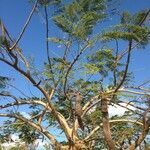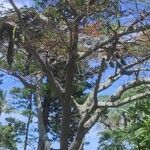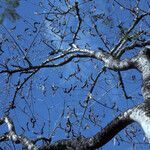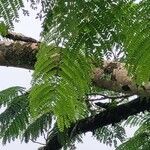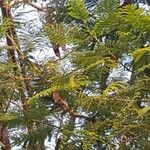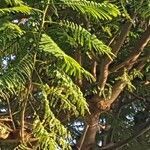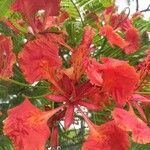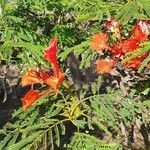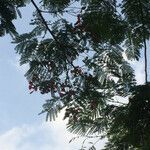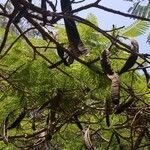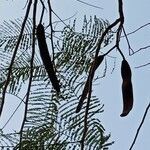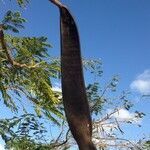Spreading tree, the branchlets subglabrous, lenticellate, corky in age. Leaves large; petiole usually about 10 cm. long, flattened and somewhat sulcate above, swollen basally; rachis up to 5 dm. long, somewhat nodose and cross-partitioned at insertion of the pinnae, tomentulose or puberulent; stipules sagittate-bifurcate (the lobes frequently dissected), caducous; pinnae up to about 20 pairs, spreading, the rachis about 12 cm. long, tomentulose; ultimate leaflets up to 40 pairs, oblong, usually nearly 1 cm. long and 3-4 mm. wide, inequilateral basally, rounded or obtuse apically, usually tomentulose or puberulent above and below especially along the veins, lighter below. Inflorescence as described for the genus; bracts ovate-lanceolate, about 6 mm. long; pedicels up to 10 or more cm. long in lowermost flowers. Flower red, very ornamental; calyx-tube from pedicellar articulation about 7 mm. tall, shallow within; calyx-lobes spatulate-lanceolate, 2.5-3 cm. long, valvate in bud, reflexed in age; petals large, about 6 cm. long, spreading, the claw about 3 cm. long, expanding apically, tomentulose within, the blade suborbicular,
Tree, deciduous, up to 10( — 15 or more) m high. Stipules pinnately 4-or 5-lobed. Leaves: main rachis 50-60 cm long; pinnae 9-20(-25) pairs, rachises up to 10 cm long. Leaflets 10-25(-40) opposite pairs per pinna, subsessile or sessile, elliptic or oblong, 5 — 10( — 15) by 2-5 mm; rounded but mucronate at apex, slightly oblique at base; finely puberulous or glabrescent. Inflorescences up to 15 cm long, glabrous, 5-10-flowered; pedicels 5-8 cm. Hypanthium shortly campanulate. Sepals oblong, 4-7 by 2-2.5 mm, acuminate, reddish on inner side. Petals unequal, total length 3-7 cm long, the blade orbicular (3-4 cm wide) and narrowed into a claw (up to 3 cm long), one yellowish white and scarlet, the others scarlet. Stamens equal in length; filaments up to 4 cm, red with white base; anthers oblong, c. 4 mm long. Ovary green, slightly velutinous; style glabrous, 2.5 cm; stigma indistinct. Pods oblong, flat, slightly curved, 30-70(-80) by 3.5-5(-7) cm, blackish, beaked. Seeds narrowly oblong-elliptic, compressed, up to 2.5 by 0.8 cm.
Deciduous tree with rather smooth, greyish brown bark. Leaves with 10–25 pairs of pinnae; stipules pinnately compound, often persistent; leaflets 10–32 pairs per pinna, oblong, 4–12 mm long, 2–5 mm wide. Inflorescences axillary or terminal, racemose. Calyx c. 2 cm long, glabrous, deeply 5-lobed; lobes ±equal. Petals 3.5–6.5 cm long, subequal but the upper one slightly longer than the others, all scarlet or sometimes (especially the upper one and the claws of the others) orange, yellowish or whitish. Staminal filaments shorter than the petals. Pod woody, 20–50 cm long, 3.5–5.5 cm wide. Seeds sunken in transverse depressions in the woody endocarp, 1.7–2 cm long, 0.6–0.7 cm wide, dark brownish black.
A tree which loses its leaves during the year in places with a long dry season. It grows to 12 m tall and spreads to 6 m wide. The trunk is stout and has knots. The bark is thick and greyish brown. The leaves are twice divided and are feathery. The leaves are bright green. They are 30-50 cm long divided into 10-25 pairs of leaflets. The flowers are orange to scarlet. They have 5 club shaped petals. Flowers are 10-13 cm across. The fruit are reddish brown long pods. The pods can be 60 cm long. They are green and flexible when young and hard and brown when mature. They contain mottled yellow seeds which are oblong.
Leaves: petiole and rachis together (11)14–35 cm long; pinnae 9–18(23) pairs; pinna rachis (4)6–12(15) cm long; leaflets 10–32 pairs per pinna, 4–11(17) × 2–4(5) mm, oblong, obtuse to rounded at the apex, asymmetrical at the base, finely appressed-pubescent on both surfaces or rarely subglabrous; stipules pinnately compound, the rachis up to 1.4 cm long, with 2–6 pairs of pinnae, each oblong or oblanceolate up to 9 × 3 mm.
usually 3-3.5 cm. wide, glabrous; stamens about 4 cm. long, tomentose basally; anthers ovate, 4-5 mm. long, bilocular; ovary linear, 1 cm. long or longer, lightly hirsute; style about 3 cm. long, glabrous; stigma terminal, pubescent, unexpanded. Legume broadly linear, frequently 4-6 dm. long and 5-7 cm. wide, scarcely curved, compressed, 2-valved, the valves ligneous; seeds oblong, transverse.
Petals (3.5)4.2–6.5(7.4) cm long, the lower 4 subequal but the upper one slightly longer than the others with the claw broader and less clearly defined, all scarlet red or sometimes (especially the upper one and the claws of the others) orange or ± yellow, the distal margins undulate.
Racemes with the axis up to 12 cm excluding the peduncle, subglabrous to sparsely pubescent, each with (3)6–14 flowers; bracts up to 9 × 5 mm, ovate or elliptic, acute at the apex, usually falling shortly before anthesis; pedicels 3.5–9(10.5) cm long.
Pods (20)30–70 × 3.6–5.8 cm, strongly woody at maturity, with seeds sunk in regular transverse cavities in the woody endocarp; seeds up to 50 or more, c.2.0 × 0.6 × 0.4 cm, linear-ellipsoid, not compressed, light brown mottled with darker brown.
Hypanthium 2–8 mm long, the narrow basal part gradually expanded above into a shallowly concave disc but the upper part not campanulate, the whole glabrous or sparsely pubescent.
Sepals 1.8–3 cm long, lanceolate to oblong, glabrous to very sparsely pubescent.
Ovary ± sessile, appressed-pubescent with longish but usually sparse hairs.
Stamen filaments (2.4)3.5–4.5(5) cm long, shorter than the petals.
Young stems subglabrous to thinly spreading-pubescent.
Tree 3–15(18) m high.
